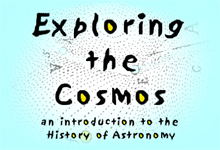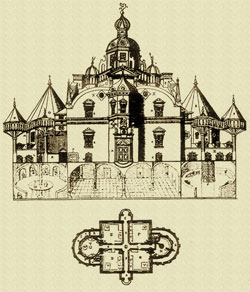

Department of History
University of California, Irvine
Instructor: Dr. Barbara J. Becker
![]()
Lecture 5. Shattering the Crystalline Spheres.
![]()
|
|
Tycho Brahe was arguably one of the greatest astronomical observers of all time. While Copernicus was a student of books (most notably Ptolemy), Tycho was a student of Nature. While Copernicus was a clergyman and conducted his research in pursuit of solutions to the Church's calendrical problems, Tycho was individually wealthy and received royal patronage to pursue his astronomical research, first on a small island in Denmark and later in Prague. Tycho viewed the sky solely with his naked eye -- there were no telescopes in his day. Nevertheless, he mapped the heavens and kept precise records of the changing positions of the planets and other celestial phenomena with the aid of an array of extraordinary sighting instruments. |
 |
Notable Events in Tycho's Life |
|
14 Dec 1546 |
Tyge Ottesen -- the sole survivor of twins -- born to Danish nobleman, Otte Brahe and his wife, Beate |
1548 |
custody and education of young Tyge assumed without contest by his childless, uncle, Jørgen Brahe, a nobleman and sheriff |
1559-1562 |
attended University of Copenhagen with expectation he would study law |
21 Aug 1560 |
observed partial solar eclipse impressed by the fact that the eclipse had been predicted, he became increasingly focused on the study of astronomy family hired a tutor in unsuccessful attempt to prevent him from pursuing his astronomical interest |
1565 |
uncle dies of pneumonia after rescuing Danish King Frederick II from drowning |
1566 |
while studying in Germany, Tycho participated in duel in which he lost part of his nose |
1572
|
observed a New Star in the constellation Cassiopeia concluded it is not an atmospheric phenomenon, but rather is located in the celestial realm |
The New Star in Cassiopeia, known as "Tyhco's Star". |
"Tycho's Star" was, in fact, what modern astronomers would call a supernova. It first appeared on 11 November 1572 and was visible through March 1574. Tycho observed it carefully during this time. He attributed the star's increase in brightness to the fact that it moves like a planet -- carried by a system of spheres (centered on the point F) which occasionally brings it much closer than usual to Earth (point A). |
1573 |
published De Nova Stella, a small book on his observations of the new star |
1575 |
attended coronation of Holy Roman Emperor, Rudolph II
forged friendship with Rudolph that would prove useful later |
1576 |
awarded island of Hven by Danish King Frederick II |
The Island of Hven |
 |
On Hven, Tycho built Uraniborg, a castle where he established a scientific research center. There were guest rooms on the first floor and chemical laboratories in the basement. Astronomical observations were conducted on the roof.
Uraniborg's Rooftop Observatory Tycho acquired an array of fine astronomical instruments, including his renowned mural quadrant depicted in the illustration below. In the background, you can see a cut-away view of Uraniborg at work. Tycho can be seen pointing up to a small window in the wall on the upper left. An assistant (in blue on the right) carefully sights a star with the quadrant while a boy holds a candle to read the clock. The scribe seated at the desk records the time and quadrant reading.
Tycho needed accurate and reliable timekeepers to map the heavens with precision. His clocks are reputed to have been a meter in diameter with over a thousand teeth. Constant improvements to his timekeeping machines enabled him to measure seconds of time by 1577. Still, he complained that he could not keep all his clocks in synchrony -- how could he tell which one, if any, kept the true time? Mechanical clocks were so unreliable in Tycho's day that he relied on a clepsydra (a water clock; possibly filled with mercury) to measure extremely small intervals of time. Thanks to royal patronage, Tycho was able to undertake long-term observation projects:
|
|
1577 |
• observed a new brilliant comet
Tycho's sketch showing the comet of 1577 in the constellation Sagittarius • coordinated his observations with those of other astronomers hoping to triangulate the comet's true distance from Earth • comparing these data, Tycho concluded the comet was always located farther than the Moon's orbit -- too far from Earth to be considered an atmospheric phenomenon, as Aristotle claimed
|
Tycho's observations of the comet's movement through the sky forced him to conclude that the comet plowed through the neatly nested crystalline spheres that astronomers had come to accept as holding the planets in their places. The illustration below is from De Mundi Aetherei Recentioribus Phaenomenis, a book Tycho published in 1588. In it he presented his theory that the comet of 1577 was a planetary body that moved around the Sun on a circle outside that of the planet Venus.
Notice that the Earth (point A) is stationary in Tycho's system of the world, while the celestial bodies move around it. Tycho was not a Copernican. The idea that the Earth moved in an orbit around the Sun defied common sense and the existing laws of physics. Furthermore, despite years of careful mapping of the fixed stars, he had found no signs of any shift in their relative positions that could be attributed to the motion of the Earth. To "save the appearances", he proposed a compromise system -- a geo-heliocentric system -- in which the Moon and Sun orbit the Earth while all other planets orbit the Sun.
|
|
1588 |
death of Tycho's patron, Frederick II; ascension of his eleven-year-old son, Christian IV, to the throne |
1597 |
after falling into increasing disfavor with the new court, Tycho left Denmark for Prague as astronomer to Holy Roman Emperor Rudolph II |
24 Oct 1601 |
death of Tycho, possibly from a urinary tract infection or obstruction; the cause of his death is still being investigated today |
|